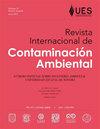Occurrence of pesticide residues in fig crops (Ficus carica L.), in Morelos, Mexico
IF 0.4
4区 环境科学与生态学
Q4 ENVIRONMENTAL SCIENCES
引用次数: 0
Abstract
The state of Morelos is the main producer of figs in the Mexican Republic, contributing 50% of the national production. Despite the fact that the official regulations in Mexico only allow the use of some pesticides on figs, it is common to find residues of prohibited substances. This work aims to assess the occurrence of pesticide residues in the fig cultivation from 15 different parcels located in Morelos in order to determine their degree of dissipation and the resultant health risk. The fig samples were analyzed using the QuEChERS multi-residue extraction, followed by gas chromatography triple quadrupole mass spectrometer, and ultra-high-performance liquid chromatography tandem mass spectrometer. Nine pesticides were detected in the sampled crops, of which five were above the maximum allowed residue levels. The pesticides with the highest concentrations were thiophanate-methyl (0.733 mg/kg), chlorothalonil (0.445 mg/kg), propamocarb (0.395 mg/kg), and carbendazim (0.313 mg/kg). All Risk Health Index values were less than 1, indicating no risk to human health. However, it is noteworthy that dietary pesticide intakes estimated in this study considered only exposures from fig fruit and did not include other fruits, vegetables, grains, dairy, fish, or meat, among others. These findings suggest the need for a continuous monitoring program for pesticide residues in cultivated vegetables in Morelos.墨西哥莫雷洛斯无花果作物中农药残留的发生
莫雷洛斯州是墨西哥共和国无花果的主要生产国,占全国产量的50%。尽管墨西哥的官方规定只允许在无花果上使用一些杀虫剂,但发现违禁物质残留的情况很常见。这项工作旨在评估莫雷洛斯15个不同地块无花果种植中农药残留的发生情况,以确定其消散程度和由此产生的健康风险。使用QuEChERS多残留提取、气相色谱-三重四极质谱仪和超高效液相色谱-串联质谱仪对无花果样品进行分析。在抽样作物中检测到9种农药,其中5种超过了允许的最大残留水平。浓度最高的农药是甲基托布津(0.733 mg/kg)、百菌清(0.445 mg/kg)、丙氨威(0.395 mg/kg)和多菌灵(0.313 mg/kg)。所有风险健康指数值均小于1,表明对人类健康没有风险。然而,值得注意的是,本研究中估计的膳食农药摄入量仅考虑了无花果果实的暴露,不包括其他水果、蔬菜、谷物、乳制品、鱼类或肉类等。这些发现表明,有必要对莫雷洛斯种植蔬菜中的农药残留进行持续监测。
本文章由计算机程序翻译,如有差异,请以英文原文为准。
求助全文
约1分钟内获得全文
求助全文
来源期刊

Revista Internacional De Contaminacion Ambiental
ENVIRONMENTAL SCIENCES-
CiteScore
0.90
自引率
16.70%
发文量
59
期刊介绍:
En esta revista se aceptan para su publicación trabajos originales y de revisión sobre aspectos físicos y químicos de la contaminación, investigaciones sobre la distribución y los efectos biológicos y ecológicos de los contaminantes; así como sobre tecnología e implementación de nuevas técnicas para su medida y control; también son aceptados estudios sociológicos, económicos y legales acerca del tema. Se publicarán los escritos que mediante arbitraje de especialistas y a juicio del Consejo Editorial tengan el nivel y la calidad adecuados para ello y su contenido será responsabilidad única de los autores. La Revista Internacional de Contaminación Ambiental es de periodicidad trimestral y se publica los días 1 de febrero, mayo, agosto y noviembre.
 求助内容:
求助内容: 应助结果提醒方式:
应助结果提醒方式:


